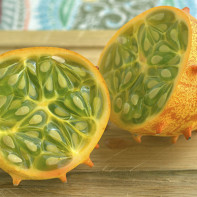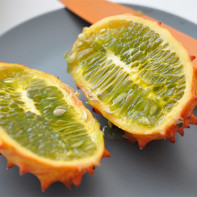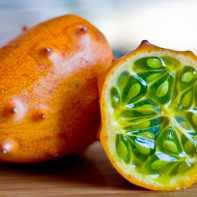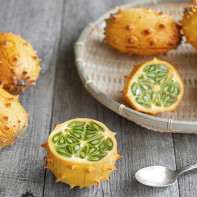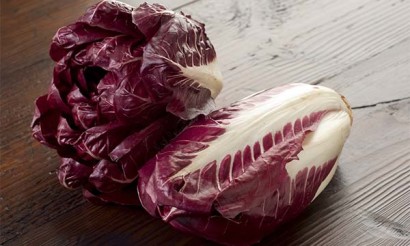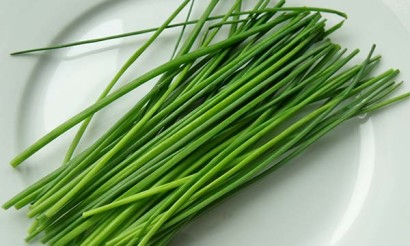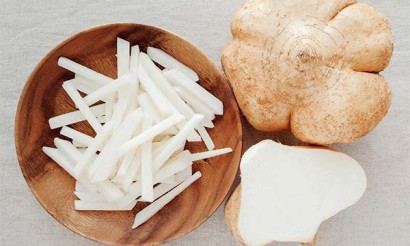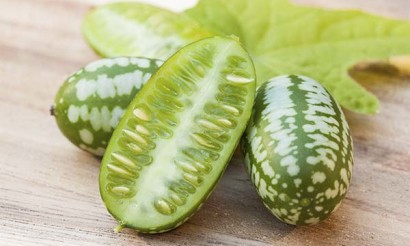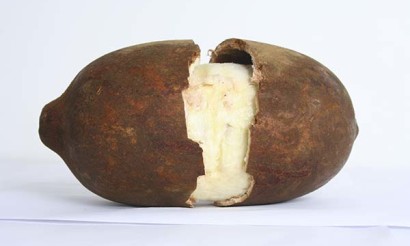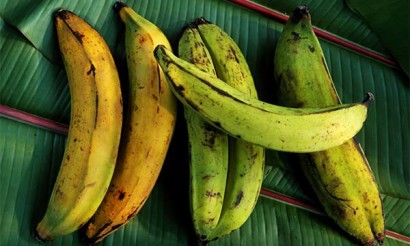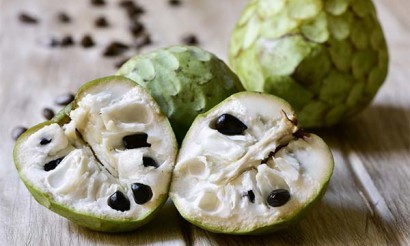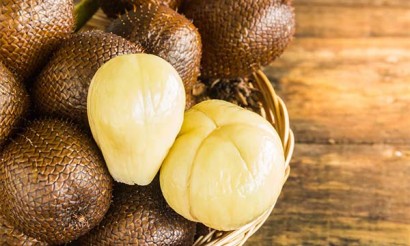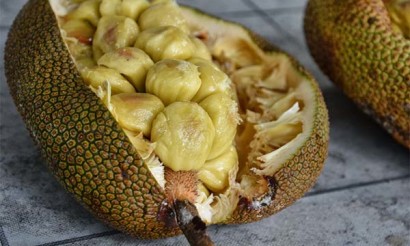Kiwanis: what kind of fruit is it and why is it useful?
The uncultivated horned melon vines, which reach three meters in length, come in two morphological types. The first yields bitter fruit and the second yields sweet fruit. There is no difference in appearance between the varieties.
What kind of fruit is it
Kiwanis is an exotic fruit that belongs to the Pumpkin family. It is also called a horned or jelly melon and an African cucumber. The plant does not tolerate drastic temperature fluctuations and likes a warm climate.
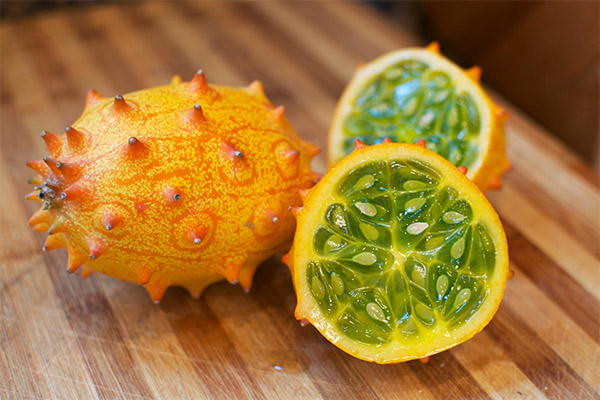
The climbing plants of the first type grow mainly in South Africa and are quite often the cause of acute poisoning. The degree of bitterness depends on the age of the fruit and the concentration of special substances - cucurbitacins. Young fruits have a slightly unpleasant taste. The fruit contains triterpene, which has an antitumor effect.
The original nickname, the horned melon, came from the fruit's dense, bright spiky surface. And the African cucumber kiwano is called because its flesh is lettuce-colored and has numerous seeds.
What it looks like
African cucumber is cultivated to produce edible fruits. The fruit resembles small oval oranges with soft spikes on the sides. The fruit has a distinct yellow, orange or red color and an inedible tough rind.
The flesh is salad-colored and consists of 90% water, it is jelly-like. The caloric value per 100 g is 44 and the protein-fat-carbohydrate ratio is 8/3/6 g. There are numerous blotches of pale green seeds in the fruit pulp, each not exceeding 1 cm. The fruits themselves are about 15 cm long, their tendrils reach 4-9 cm, and the circumference does not exceed 10 cm. They weigh about 300-400 grams.
The horned melon can be called a fruit conditionally. Biologically, it is a pumpkin vegetable, which is a relative of common cucumbers. The taste resembles that of a watery banana. The fruit is consumed both ripe and unripe.
In some African areas, liana leaves are also used in cooking. The pulp is sprinkled with sugar or salt. In unsweetened salads it is combined with the usual spices - salt, pepper and paprika - and lemon juice, added to fruit and dairy drinks. Because of its low nutritional value, the horned melon is beloved by dieters.
Where does it grow
The kiwano is native to Africa. The crop is grown in tropical and subtropical areas of the Sahara, Kenya, Senegal, Yemen and the southern regions of the hot continent. It is also widely cultivated in countries in the southern United States and Central America, and is cultivated in France, Croatia and Israel.
New Zealand was the first country to supply the horned melon to a wide market. Exports have been established since the 1980s. It was there that the fruit got its name - "kiwano. Marketers chose this name in order to successfully market the product in the Japanese and American markets. After a while, African cucumbers began to be cultivated in the United States, then the regions of Israel and Kenya for European consumers. Recently, French breeders successfully planted the seeds of the plant and got the first harvest.
What is kiwano good for?
The fruit pulp contains many elements that humans need. In the chemical composition of the kiwano can be found compounds:
- copper;
- phosphorus;
- sodium;
- iron;
- potassium;
- manganese;
- magnesium.
The fruit is also rich in vitamins A and B, ascorbic and folic acid, organic salts of alkaline nature, P-active substances and useful carbohydrates.
Jelly melons are one of the lowest-calorie foods that can be consumed even on the most restrictive diets. But they are good for the walls of blood vessels and heart, nervous system, liver, kidneys, pancreas and skin. After the introduction of quinoa into the diet, the process of cleansing from toxins and detoxes is accelerated. Fruits are recommended to use during cold epidemics, because the fruit helps to improve the immune system and strengthen the body's defenses.
The beneficial effects of the product are as follows:
- Thinning of the blood - this is due to the high water content, which prevents the appearance of cholesterol plaques, resulting in the prevention of coronary heart disease, heart attacks, strokes and thrombosis.
- Reducing BP - useful for rheumatism and arterial hypertension at any stage of development.
- Reducing the amount of harmful glucose - relevant in diabetes, because the disease is characterized by sugar levels above 6.8 units, and African cucumbers quickly quench attacks of hunger and thirst, which arise with a sharp increase in glucose levels.
- Restoration of water-salt balance - due to the high percentage of water, jelly melons help saturate cells with moisture and oxygen, which means premature aging and the possibility of a new growth is prevented.
- Improving digestion - dietary fiber envelops the mucous membranes of the stomach and intestines, regenerating them, fiber prevents flatulence, eliminates diarrhea and constipation, normalizes the flow of bile.
- Normalization of immune function - ascorbic acid reduces the risk of getting sick during the spread of viruses and infections, improves the overall condition of the body and the appearance of the skin - peeling stops.
- Strengthening the walls of the joints - magnesium helps in eliminating the signs of osteoporosis, arthritis, bursitis and rheumatism, a sufficient concentration of the element is important during rehabilitation after serious injuries, hypothermia and cartilage overstress.
- Increasing hemoglobin levels - thanks to iron and folic acid more red blood cells are formed, blood cells suppress the effects of pathogenic bacteria.
Advocates of alternative medicine in African tribes use the fruit pulp to stop bleeding or remove traces of burns, because the subcutaneous part of the fruit has an astringent and healing effect.
What harm can come from
Serious consequences arising after eating horned melon have not been recorded. When you first take it, you need to be careful to avoid allergic manifestations, because kiwano is exotic and unfamiliar to the body. Especially, you should treat the fruit with caution to a person who suffers from food allergies.
Limit the use of the fruit should:
- with gastritis;
- inflammation of the mucous membranes of the mouth;
- colitis;
- hypotension.
If after the African cucumber has been eaten, no changes have occurred, you can safely enjoy the new taste.
How to choose
When buying kiwano, you should pay attention to its hue. Juicy fruits have a bright orange color. Preference should be given to medium-sized fruits, which should be free of lesions and spots. Ripe horned melons can be eaten immediately. If transportation is planned, buy slightly green unripe specimens. After 5-7 days, the fruits ripen and enjoy freshness.

Long storage of African cucumbers is allowed, just choose a cool place. Fruits ripen faster in sunny places. Everyone describes the taste differently. The first recognize the combination of melon and cucumber, the second - banana and lime, the third - apple and kiwi.
Kiwanis peels are also used for decorative purposes. The husk is rid of pulp and dried. Obtain original dessert containers. And if you do not divide the fruit in half, and just cut off the tops, you get unusual cocktail vessels.
How to eat a quinoa properly
Since the taste sensations are different, it is better to buy and try an exotic kiwano. For this purpose, ripe fruits are washed, cut in half and eaten with a spoon. Their consistency is jelly-like. Not quite ripe fruits are cut into slices with a knife and seasoned with spices.
In addition to being eaten raw, African cucumbers are added to jams and compotes. Because of the undecipherable taste of the flesh, they can be sweet, salty or spicy if desired. Kiwanis is pleasant in any interpretation: in juices, second courses, sandwiches, snacks and desserts. At home the fruit is used in combination with tomatoes, radishes and sweet peppers, with light mousse creams or in a pickled form.
What you can make with quinoa
The horned melon is good for creative dishes and those who want to try something new. Foodies loved the tropical fruit because of its peculiar consistency and unusual taste.
Delicate sherbet
Calculated for 4 servings:
- Kiwanis - 1 pc;
- fresh orange juice - 200 ml;
- condensed milk - 65 gr;
- Coconut liqueur - 1 tsp;
- natural yogurt - 100 g.
Preparation:
- In a deep bowl, mix all the ingredients, pre-shredding the pulp of the jelly melon and getting rid of the pith from the orange. Place in the fridge for 3 to 4 hours.
- Whip the billet with a blender until smooth. Pour into a container and put it in the freezer.
- Form the balls from the frozen mixture with an ice-cream scoop, pour your favorite syrup and serve.
Unusual soup
Calculated for 4 servings:
- jelly melon - 5 pcs;
- Smoked bacon - 150 gr;
- clean water - 500 ml;
- pork ribs - 250 gr;
- chicken - 320 gr;
- salt, garlic, spices, herbs - as you wish.
Preparation:
- First of all, make the Kiwanis juice - remove the skin, take out the seeds and mash. Add water, beat with a blender - lumps should be completely dissolved. We filter the juice and discard the cake.
- Cook on medium heat for 1.5-2 hours and add all the meat ingredients. But before that, we chop the bacon and chicken.
- Salt and add spices, chopped garlic. Cook for one hour. Sprinkle with greens and serve.
Cosmetological applications
The exotic fruit has also spread in cosmetology. Renowned companies use the jelly melon in eye, neck and face care products. Nourishing mask can be prepared by yourself.
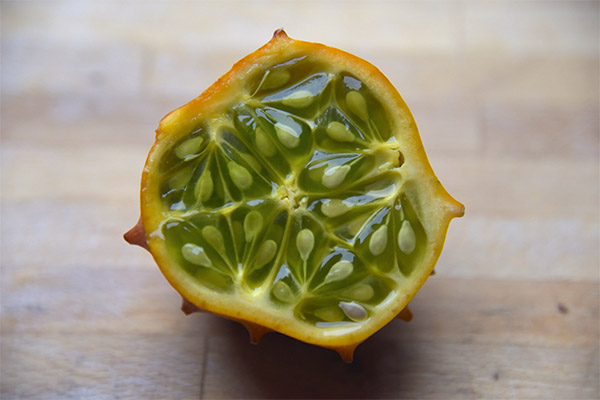
You will need:
- Kiwanis - 1/2 pc;
- sour apple - 1/2 pc;
- honey - 20 gr;
- clay - 25 gr;
- egg yolk - 1 pc.
Preparation:
- Grate the apple on a fine grater. Peel horned melon, take out the seeds and mash with a fork.
- Mix the crushed ingredients with honey, clay and egg yolk.
- The resulting homogeneous pulp is evenly applied to the skin of the face with massaging movements - light tapping or stroking activates the particles, which increases the effectiveness of the procedure.
- After 15-20 minutes, rinse with warm water and apply moisturizing cream.
How to grow kiwano
If you managed to choose a ripe fruit of jelly melon, you can wash the seeds and plant them in mid-spring. The plant will also take root in the apartment, if you provide proper care. Choose only whole and large seeds. Planting the latter is carried out in several stages:
- Soak in an aqueous solution of sodium humate or in fertilizer "Epin-extra".
- After swelling, put in a warm place for three days and wait for germination - this will increase the likelihood of germination.
- Plant in nutritious soil to a depth of 3.5-4 mm.
- Cover the pots with cling film and wait for sprouts.
- Regularly water the sprouts.
When growing nodule plants you need to follow some rules of care:
- Maintain a temperature of 20-25°C.
- Provide a long light day with a fluorescent lamp.
- Protect from direct sunlight, otherwise stains and burns will form.
- Loosen up every 2-3 days.
After a month the shoots can be planted in the open ground. Young shoots grow and sprawl very quickly, it is preferable to place the horned melon along fences or flat surfaces. Holes of 40x35 cm are placed with a spacing of 70-100 cm. The root system of the plant is located close to the surface and will not withstand drought and stagnant water. The optimal mode of watering is a couple of times a week, provided that the weather is not very hot. If the soil is covered with a crust, in the morning or evening, we conduct loosening.
For an abundant harvest fertilize the soil every 10 days with mineral and organic fertilizers. The fruits are plucked after they turn a bright orange color. With proper care, the kiwano yields about 200-250 fruits per season, stored for up to six months. To stock jelly melons, the fruit is canned with salt or sugar.
«Important: All information on this site is provided for informational purposes only. for informational purposes only. Please consult with your health care professional before using any of the recommendations. specialist before using any of the recommendations. Neither the editors nor the authors shall be liable for any possible harm caused by materials."

